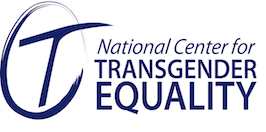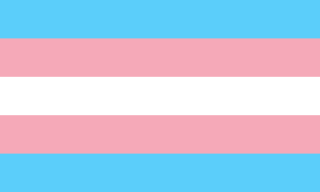
Transphobia consists of negative attitudes, feelings, or actions towards transgender people or transness in general. Transphobia can include fear, aversion, hatred, violence or anger towards people who do not conform to social gender roles. Transphobia is a type of prejudice and discrimination, similar to racism, sexism, or ableism, and it is closely associated with homophobia. People of color who are transgender experience discrimination above and beyond that which can be explained as a simple combination of transphobia and racism.

A trans man is a man who was assigned female at birth. Trans men have a male gender identity, and many trans men undergo medical and social transition to alter their appearance in a way that aligns with their gender identity or alleviates gender dysphoria.

The National Center for Transgender Equality (NCTE) is a nonprofit social equality organization founded in 2003 by transgender activist Mara Keisling in Washington, D.C. The organization works primarily in the areas of policy advocacy and media activism with the aim of advancing the equality of transgender people in the United States. Among other transgender-related issue areas, NCTE focuses on discrimination in employment, access to public accommodations, fair housing, identity documents, hate crimes and violence, criminal justice reform, federal research surveys and the Census, and health care access.

The Transgender Day of Remembrance (TDoR), also known as the International Transgender Day of Remembrance, has been observed annually from its inception on November 20 to memorialize those who have been murdered as a result of transphobia. The day was founded to draw attention to the continued violence directed toward transgender people.

Stephen Thomas Whittle, is a British legal scholar and activist with the transgender activist group Press for Change. Since 2007, he has been Professor of Equalities Law in the School of Law at Manchester Metropolitan University. Between 2007 and 2009, he was president of the World Professional Association for Transgender Health (WPATH). Having been assigned female at birth, he is described as "a radical lesbian before his sex change and now a leading commentator on gender issues", who after the Gender Recognition Act 2004 came into force in April 2005, achieved legal recognition as a man and so was able to marry his female partner.

Sexual attraction to transgender people has been the subject of scientific study and social commentary. Psychologists have researched sexual attraction toward trans women, trans men, cross dressers, non-binary people, and a combination of these. Publications in the field of transgender studies have investigated the attraction transgender individuals can feel for each other. The people who feel this attraction to transgender people name their attraction in different ways.

Sexuality in transgender individuals encompasses all the issues of sexuality of other groups, including establishing a sexual identity, learning to deal with one's sexual needs, and finding a partner, but may be complicated by issues of gender dysphoria, side effects of surgery, physiological and emotional effects of hormone replacement therapy, psychological aspects of expressing sexuality after medical transition, or social aspects of expressing their gender.

LGBTQ movements in the United States comprise an interwoven history of lesbian, gay, bisexual, transgender and queer social movements in the United States of America, beginning in the early 20th century. A commonly stated goal among these movements is social equality for LGBTQ people. Some have also focused on building LGBTQ communities or worked towards liberation for the broader society from biphobia, homophobia, and transphobia. LGBTQ movements organized today are made up of a wide range of political activism and cultural activity, including lobbying, street marches, social groups, media, art, and research. Sociologist Mary Bernstein writes:
For the lesbian and gay movement, then, cultural goals include challenging dominant constructions of masculinity and femininity, homophobia, and the primacy of the gendered heterosexual nuclear family (heteronormativity). Political goals include changing laws and policies in order to gain new rights, benefits, and protections from harm.

A transgender person is someone whose gender identity differs from that typically associated with the sex they were assigned at birth.

Lesbian, gay, bisexual, transgender and queer (LGBTQ) people face difficulties in prison such as increased vulnerability to sexual assault, other kinds of violence, and trouble accessing necessary medical care. While much of the available data on LGBTQ inmates comes from the United States, Amnesty International maintains records of known incidents internationally in which LGBTQ prisoners and those perceived to be lesbian, gay, bisexual or transgender have suffered torture, ill-treatment and violence at the hands of fellow inmates as well as prison officials.

Louis Graydon Sullivan was an American author and activist known for his work on behalf of trans men. He was perhaps the first transgender man to publicly identify as gay, and is largely responsible for the modern understanding of sexual orientation and gender identity as distinct, unrelated concepts.

The transgender rights movement is a movement to promote the legal status of transgender people and to eliminate discrimination and violence against transgender people regarding housing, employment, public accommodations, education, and health care. A major goal of transgender activism is to allow changes to identification documents to conform with a person's current gender identity without the need for gender-affirming surgery or any medical requirements, which is known as gender self-identification. It is part of the broader LGBT rights movements.

This article addresses the history of transgender people in the United States from prior to Western contact until the present. There are a few historical accounts of transgender people that have been present in the land now known as the United States at least since the early 1600s. Before Western contact, some Native American tribes had third gender people whose social roles varied from tribe to tribe. People dressing and living differently from the gender roles typical of their sex assigned at birth and contributing to various aspects of American history and culture have been documented from the 17th century to the present day. In the 20th and 21st centuries, advances in gender-affirming surgery as well as transgender activism have influenced transgender life and the popular perception of transgender people in the United States.
Discrimination against non-binary people, people who do not identify exclusively as male or female, may occur in social, legal, or medical contexts.
Transgender Awareness Week, observed November 13 to November 19, is a one-week celebration leading up to the Transgender Day of Remembrance (TDoR), which memorializes victims of transphobic violence. TDoR occurs annually on November 20, when transgender advocates raise awareness of the transgender community through education and advocacy activities.
Rupert Raj is a Canadian trans activist and a transgender man. His work since his own gender transition in 1971 has been recognized by several awards, as well as his inclusion in the National Portrait Collection of The ArQuives: Canada's LGBTQ2+ Archives.
The National LGBTQ Wall of Honor is a memorial wall in the Greenwich Village neighborhood of Manhattan in New York City, dedicated to LGBTQ "pioneers, trailblazers, and heroes". Located inside the Stonewall Inn, the wall is part of the Stonewall National Monument, the first U.S. National Monument dedicated to the country's LGBTQ rights and history. The first fifty inductees were unveiled June 27, 2019, as a part of events marking the 50th anniversary of Stonewall. Five honorees are added annually.

The Book of Pride: LGBTQ Heroes Who Changed The World is a 2019 book by Mason Funk. It contains interviews and biographies of members of the LGBT community and advocates compiled by The OUTWORDS Archive. It was published by HarperCollins. There is a mix of well-known and unsung heroes of the LGBT movement.
FTM International is the oldest organization for trans men in the United States. Founded by Lou Sullivan in 1986, it is dedicated to the provision of resources for FTM individuals along with creating a visible community.
The following is a timeline of transgender history. Transgender history dates back to the first recorded instances of transgender individuals in ancient civilizations. However, the word transgenderism did not exist until 1965 when coined by psychiatrist John F. Oliven of Columbia University in his 1965 reference work Sexual Hygiene and Pathology; the timeline includes events and personalities that may be viewed as transgender in the broadest sense, including third gender and other gender-variant behavior, including ancient or modern precursors from the historical record.













